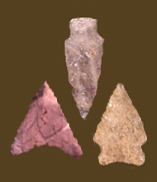
|
MEADOWOOD Defining Attributes Chronology Although Ritchie (1971), in his initial type description, associated the Meadowood point with radiocarbon dates as early as 2448 BC, most consider it an Early Woodland period type. Funk (1993) places it between 1000 and 560 BC (approximately 1300-750 BC in calendar years) in eastern New York and the Delaware Valley, although a questionable radiocarbon date of 1230 BC (roughly 1500 BC calendar) was obtained at one site. Tache (2011) suggests a date range of 1000 to 400 BC (1300-425 BC calendar). The Nassawango site in Worcester County, Maryland produced a Meadowood point dated to 2445 +/- 100 BP, while another Meadowood site on the Delmarva Peninsula had dates ranging from 970 BC to 700 BC calendar (Lowery 2012). Description Haft Element: The type is neatly side notched low on the point. Double notched, corner notched, and box-base points with small side notches are occasional variants (Tache 2011). Notch openings are narrow, and are usually shallow to moderately deep. The base can be convex or straight, and is sometimes considerably wider than the blade. The base is often thinned, and grinding is common around the edges and notches. Size: The point ranges from 41 to 89 mm in length, with the majority between 43 and 77 mm. The width ranges from 13 to 36 mm, with an average of 28 mm. The thickness rarely exceeds 5 mm. Technique of manufacture: Soft percussion flaking, followed by well-controlled pressure flaking showing great skill. Material: In the Monocacy River drainage, 58% of 12 Meadowood points were rhyolite, with 25% chert and 8.5% each of quartzite and jasper (Kavanagh 1982). In the middle Potomac Valley, chert, quartzite, and rhyolite Meadwood points have been found, but they are not common (Hranicky 2002). At the Abbott Farm site complex in New Jersey, chert was the most common Meadowood material, followed by jasper and argillite (Wall et al. 1996). Discussion Defined in Literature The Meadowood point was first defined by Ritchie in 1961 (revised 1971). References |
![]()
Search by Shape:
(See Projectile Point Typology) |

|
Thank you for visiting our website. If you have any
questions, comments, Copyright © 2002 by |

|

